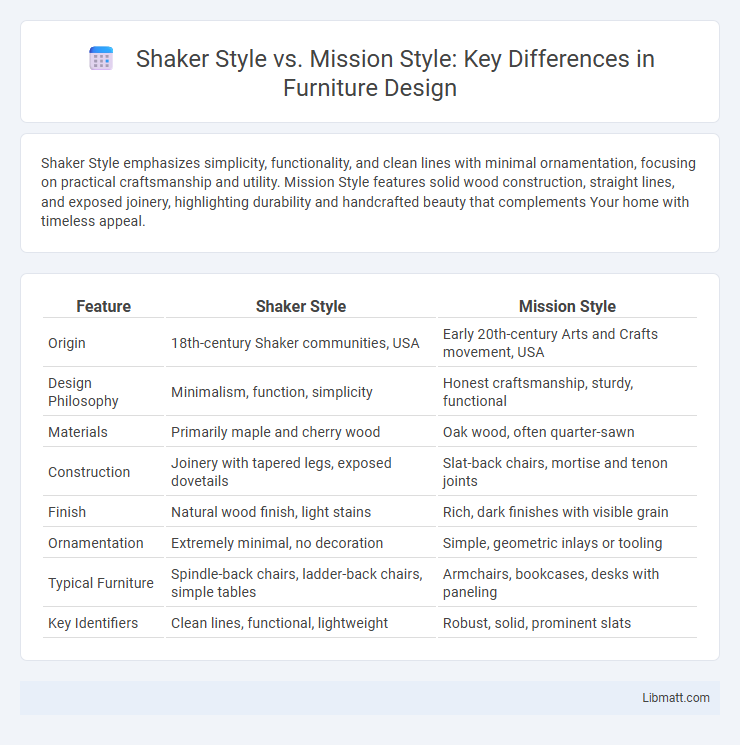Shaker Style emphasizes simplicity, functionality, and clean lines with minimal ornamentation, focusing on practical craftsmanship and utility. Mission Style features solid wood construction, straight lines, and exposed joinery, highlighting durability and handcrafted beauty that complements Your home with timeless appeal.
Table of Comparison
| Feature | Shaker Style | Mission Style |
|---|---|---|
| Origin | 18th-century Shaker communities, USA | Early 20th-century Arts and Crafts movement, USA |
| Design Philosophy | Minimalism, function, simplicity | Honest craftsmanship, sturdy, functional |
| Materials | Primarily maple and cherry wood | Oak wood, often quarter-sawn |
| Construction | Joinery with tapered legs, exposed dovetails | Slat-back chairs, mortise and tenon joints |
| Finish | Natural wood finish, light stains | Rich, dark finishes with visible grain |
| Ornamentation | Extremely minimal, no decoration | Simple, geometric inlays or tooling |
| Typical Furniture | Spindle-back chairs, ladder-back chairs, simple tables | Armchairs, bookcases, desks with paneling |
| Key Identifiers | Clean lines, functional, lightweight | Robust, solid, prominent slats |
Introduction to Shaker and Mission Styles
Shaker Style embodies simplicity and functionality, characterized by clean lines, minimal ornamentation, and a focus on craftsmanship rooted in the 18th-century Shaker community. Mission Style, emerging in the early 20th century, emphasizes sturdy construction, exposed joinery, and natural wood finishes inspired by the Arts and Crafts Movement. Both styles prioritize practicality but differ in visual expression, with Shaker favoring austere elegance and Mission highlighting rustic, handcrafted appeal.
Historical Origins of Shaker and Mission Furniture
Shaker furniture originated in the late 18th century from the Shaker religious community, emphasizing simplicity, functionality, and craftsmanship rooted in their values of humility and utility. Mission style furniture emerged in the early 20th century, inspired by the Arts and Crafts movement and influenced by Spanish colonial design, focusing on sturdy forms and natural wood finishes. Understanding the historical origins of Shaker and Mission furniture helps you appreciate the distinct cultural and design philosophies shaping each style.
Core Design Philosophies Compared
Shaker Style emphasizes simplicity, functionality, and craftsmanship rooted in Quaker principles, featuring clean lines and minimal ornamentation to foster utility and modesty. Mission Style, inspired by Spanish colonial architecture, prioritizes sturdy construction, exposed joinery, and natural materials, highlighting a connection to handcrafted artisanship and the American Arts and Crafts movement. Both styles value practicality and honesty in materials, but Shaker design leans more toward restraint and utility, while Mission style embraces rustic warmth and decorative wood grain visibility.
Materials and Construction Techniques
Shaker Style furniture emphasizes simplicity and functionality, utilizing hardwoods like cherry, maple, and cherry for durability and a smooth finish, with joinery techniques such as finger joints and dovetails ensuring strength without nails or screws. Mission Style furniture showcases solid oak with visible grain and a rich, warm stain, constructed using mortise and tenon joints to support its robust, rectilinear form. Both styles highlight craftsmanship but diverge in materials, with Shaker opting for lighter woods and refined detailing while Mission emphasizes sturdy, rustic oak and exposed joinery.
Key Features of Shaker Style
Shaker style furniture is characterized by its minimalist design, emphasizing functionality with clean lines and simple forms that avoid unnecessary ornamentation. Crafted from durable woods like maple and cherry, Shaker pieces often feature tapered legs, rounded edges, and flat panel doors that highlight expert joinery. You'll appreciate Shaker style for its blend of practicality and elegance, ideal for creating timeless, uncluttered interiors.
Defining Characteristics of Mission Style
Mission Style furniture is defined by its straight lines, flat panels, and emphasis on sturdy, functional design often constructed from oak with visible joinery such as mortise-and-tenon. Its natural finish highlights the wood grain, reflecting the Arts and Crafts movement's focus on simplicity and craftsmanship. You will find that Mission Style prioritizes practicality and durability, featuring minimal ornamentation and a handcrafted appearance.
Color Palettes and Finishes
Shaker Style typically features a light, natural color palette with finishes in clear varnish or muted stains that highlight the wood grain, often using maple, cherry, or pine. Mission Style embraces deeper, richer hues such as dark oak or teak with matte or satin finishes that emphasize straight, sturdy lines and the wood's natural texture. Both styles favor simplicity but differ in color warmth and surface treatment, with Shaker leaning toward understated elegance and Mission prioritizing robust, earthy tones.
Functional Differences in Usage
Shaker Style emphasizes simplicity and functionality with minimalist design, featuring open shelving and multi-purpose furniture ideal for efficient storage and workspace organization. Mission Style showcases sturdy construction with solid wood and detailed joinery, prioritizing durability and structural integrity suitable for heavy use in living areas. Your choice depends on whether you value streamlined, adaptable pieces (Shaker) or robust, decorative furniture (Mission) for daily use.
Popularity and Influence in Modern Homes
Shaker Style remains popular in modern homes for its clean lines, minimalism, and functional design that complements contemporary interiors. Mission Style influences are evident in the use of solid wood, exposed joinery, and handcrafted details, appealing to homeowners who value craftsmanship and rustic charm. Your choice between these styles can enhance a home's aesthetic by reflecting simplicity or artisanal heritage.
Choosing Between Shaker and Mission for Your Space
Choosing between Shaker and Mission styles depends on your preference for simplicity versus structure. Shaker furniture emphasizes clean lines, minimal ornamentation, and functional design, ideal for creating an airy, uncluttered space. Mission style features sturdy construction with exposed joinery and vertical slats, perfect for adding a warm, craftsman aesthetic to a room.
Shaker Style vs Mission Style Infographic

 libmatt.com
libmatt.com